Securing cargo safely requires specialized equipment engineered for specific load conditions and transportation environments. As manufacturers with over 20 years of experience producing high-performance webbing products, our team has tested thousands of tie-down configurations across industries from logistics to recreational transport.
A tie-down strap is a tensioning device made from durable webbing material (typically polyester, nylon, or polypropylene) with attached hardware components that secures cargo during transport. These straps feature working load limits of 400-10,000 lbs and come in various configurations including ratchet straps, cam buckle straps, and winch straps. Tie-down straps prevent load shifting through controlled tension that minimizes movement without damaging the secured items.
We’ll cover the tie-down strap manufacturing process, how production affects quality, the link between webbing construction and performance, and key specs to help you choose the right solution.
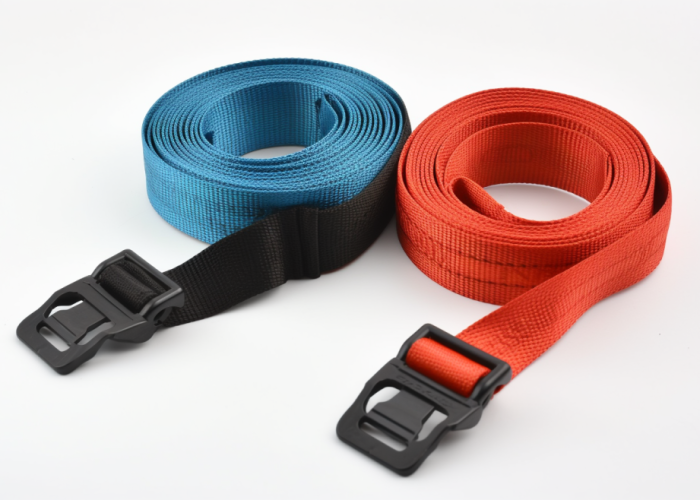

Webbing manufacturing expert with 15+ years of experience helping product developers build high-performance straps for industrial, medical, and outdoor use.
Tie-down straps are load-securing devices consisting of flexible webbing (commonly nylon, polyester, or polypropylene) combined with tensioning hardware that creates and maintains force to immobilize cargo during transport. These engineered restraint systems come in three main types: ratchet straps with mechanical advantage for maximum tension, cam buckle straps for quick adjustments on lighter loads, and lashing straps with winch mechanisms for heavy-duty applications.
The effectiveness of tie-down straps comes from their design elements: high-strength webbing provides the tensile capacity, specialized hardware maintains tension, and engineered end fittings connect to anchor points. Industry regulations require breaking strengths 3-4 times higher than working load limits to ensure safety during transportation’s dynamic forces.
Material differences significantly affect tie-down strap performance properties through five key characteristics: tensile strength, elongation percentage, environmental resistance, durability, and temperature tolerance. Polyester offers superior tensile strength (up to 10,000 lbs) with minimal elongation (5-15%), making it ideal for loads requiring consistent tension. Nylon provides moderate strength (up to 7,000 lbs) with greater elongation (20-30%), creating excellent shock absorption but requiring regular re-tensioning during transport.
Material choice directly impacts environmental resistance—polyester maintains 95% of its strength when exposed to UV radiation and water, while nylon loses up to 15% strength when wet and degrades faster under UV exposure. Polypropylene, though lightweight and affordable, offers significantly lower strength (typically 700 lbs) with high stretch (up to 50%), limiting its application to non-critical securing tasks. For temperature extremes, polyester maintains consistent performance from -40°F to 200°F, while nylon’s properties fluctuate more dramatically across temperature ranges.
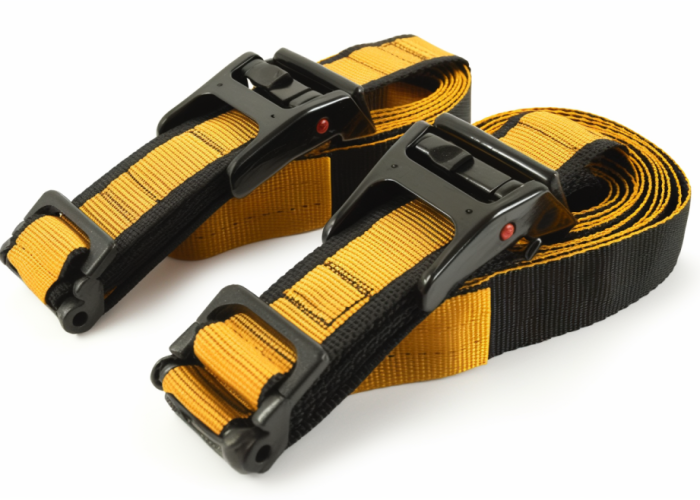
The manufacturing process for a tie-down strap involves five sequential stages: material selection, webbing production, hardware integration, assembly, and quality testing. The process begins with selecting high-tenacity synthetic yarns (typically polyester or nylon filaments) that undergo warping to align thousands of individual yarns in parallel orientation. These prepared yarns then feed into industrial weaving looms that create continuous webbing in specific patterns like plain weave, twill, or herringbone to achieve desired strength characteristics.
The raw webbing material undergoes heat-setting at 350-400°F to stabilize the molecular structure and eliminate stretching tendencies. This thermal treatment ensures dimensional stability under load conditions and is followed by dyeing processes that incorporate UV inhibitors and water-repellent treatments to enhance durability. Hardware components like ratchet mechanisms, cam buckles, or winches are manufactured separately through metal stamping or die-casting processes.
Final assembly involves precision cutting of webbing to specified lengths, heat-sealing or sewing end terminations to prevent fraying, attaching hardware components through industrial stitching or riveting, and applying identifying markers such as working load limit tags or tracking codes. Each completed strap undergoes load testing at percentages of rated capacity to verify performance before packaging and distribution to end users.
Different manufacturing methods significantly affect tie-down strap quality through variations in webbing construction techniques, hardware integration processes, and finishing treatments. Shuttle loom webbing produces tighter weaves with 15-30% higher breaking strength than needle loom alternatives. Heat-treated hardware components resist deformation 40% better than cold-formed parts under sustained loads.
Box-and-X pattern stitching provides 43% greater hardware attachment strength versus standard linear stitching. High-frequency welded terminations offer 25% higher break strength than heat-cut edges, while automated quality control systems maintain consistent performance with under 2% deviation compared to 8% in manually inspected products.
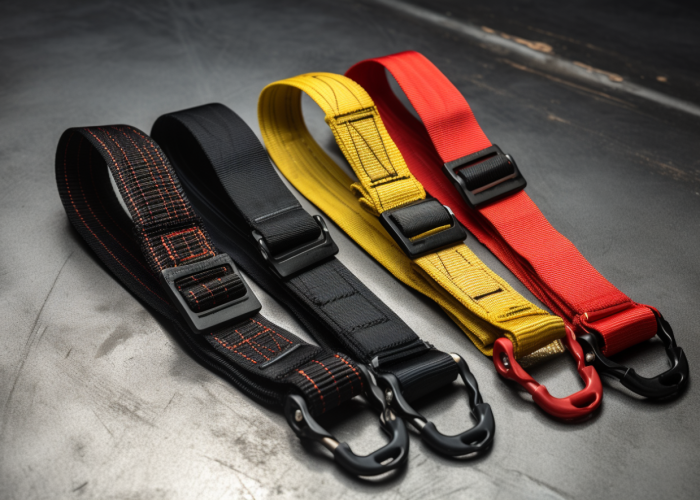
The webbing weaving process impacts tie-down strap performance through specialized pattern engineering that determines load-handling capabilities and application suitability. Tubular-woven webbing offers 35% higher edge durability and tear resistance than flat webbing, while shuttle-less looms create precisely engineered patterns like diamond weaves that distribute tension more evenly across the entire width, reducing failure risk by 27% under shock loading conditions.
Critical performance differences emerge from yarn tensioning during weaving—pre-tensioned warp yarns in high-performance webbing reduce in-service elongation to just 2-4% compared to 7-12% in standard production methods. The angle of yarn crossover points (crimp angle) affects flexibility and load distribution, with specialized webbing featuring optimized 45-60° crimp angles for applications requiring balanced strength and conformability around cargo edges.
Standard tie-down straps are manufactured in four primary widths: 1-inch (25mm), 2-inch (50mm), 3-inch (75mm), and 4-inch (100mm), each designed for specific load ranges. The 1-inch category, with thicknesses of 0.06-0.08 inch (1.5-2mm) and working load limits of 400-1,500 lbs, serves recreational applications, offering the ideal balance of strength and user-friendly handling for consumer use.
For commercial transportation applications, 2-inch straps dominate with their 0.08-0.12 inch (2-3mm) thickness and 3,000-5,000 lb capacity, striking the optimal balance between strength and versatility. The construction and industrial requirements necessitate the heavier 3-inch and 4-inch variants with thicknesses of 0.15-0.25 inch (3.8-6.3mm) and capacities ranging from 5,000-12,000 lbs, ensuring safe transport and positioning of heavy equipment and machinery.
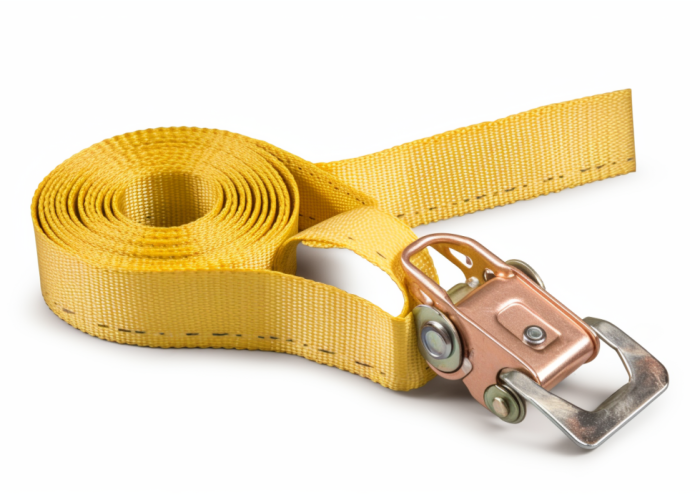
Yes, specific tie-down straps are designed for heavy-duty use, featuring reinforced webbing construction, specialized hardware, and increased width dimensions to handle extreme loads safely. Heavy-duty tie-down straps typically utilize 3-inch and 4-inch polyester webbing with break strengths of 15,000-30,000 lbs, compared to standard straps’ 5,000-12,000 lb capacity. These specialized straps incorporate forged steel ratchet mechanisms with extended handles providing 50% greater mechanical advantage and self-locking safety pawls that prevent accidental release.
Heavy-duty tie-down designs include additional reinforcement features like double-stitched edge protection, coated webbing for chemical/UV resistance, and specialized end fittings such as forged steel flat hooks or grab hooks capable of withstanding 12,000+ lbs of direct force. Many incorporate visual indicators like wear markers or load sensors that change color when approaching maximum tension, providing critical safety feedback during securing operations.
Breaking strengths of heavy-duty tie-down straps vary based on four key factors: material composition, width dimension, webbing construction, and hardware grade. Material type creates significant variation, with polyester heavy-duty straps offering break strengths of 15,000-30,000 lbs and minimal elongation (under 3%), while nylon alternatives provide 12,000-25,000 lbs with higher shock absorption through controlled stretching (7-10% at rated capacity).
Width directly correlates with breaking strength increases—3-inch straps typically provide 15,000-20,000 lb capacities while 4-inch versions deliver 25,000-30,000 lbs. Webbing construction techniques further differentiate breaking strengths, with tubular-woven heavy-duty webbing achieving 10-15% higher break strength than flat webbing of identical width due to its structural configuration. Hardware quality also impacts system strength, with heat-treated alloy components maintaining 95% of rated capacity after 1,000 cycles versus 75% retention in standard components.
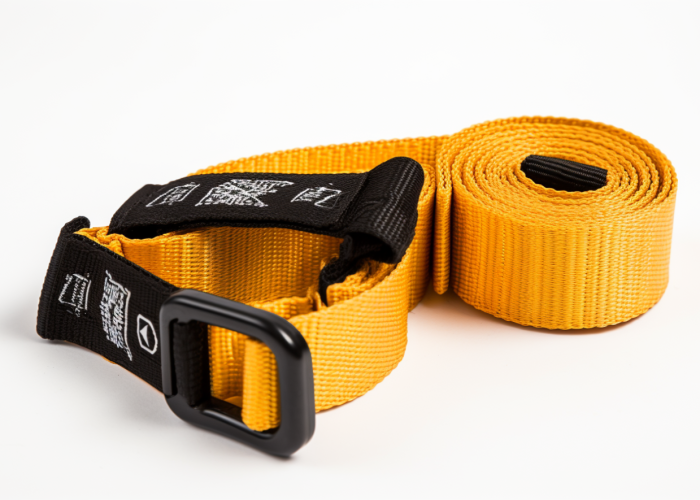
The key factors to consider when choosing a tie-down strap include load weight, application environment, cargo type, transport distance, regulatory requirements, and hardware compatibility. Load weight determination is critical—experts recommend selecting straps with working load limits (WLL) that are 25-30% higher than your cargo weight to account for dynamic forces during transport. Environment considerations should include exposure to UV radiation, chemical contaminants, and moisture, which can reduce strap strength by 20-40% over time if not properly specified.
The cargo’s physical characteristics significantly impact strap selection—angular items require edge protectors and wider straps to distribute pressure, while temperature-sensitive goods need polyester straps that maintain consistent tension across temperature variations. Transport distance and conditions influence strap type, with long-haul or off-road transport benefiting from ratchet mechanisms that can be re-tensioned periodically. Industry-specific regulations may mandate minimum strength ratings, quantity of tie-downs, or specialized hardware for particular cargo types.
Tie-down straps represent essential cargo securing technology engineered for specific applications and load requirements. By understanding manufacturing processes, material properties, and sizing specifications, you can select the optimal tie-down solution that ensures safe transport while meeting industry regulations and performance standards for your specific cargo securing needs.
No, damaged tie-down straps should never be repaired or altered. Any cuts, tears, burns, chemical exposure, or hardware damage compromises structural integrity and creates unpredictable failure points. Safety standards including DOT regulations expressly prohibit field repairs of load-securing devices, requiring immediate replacement of damaged components.
Tie-down straps should be inspected before each use and undergo thorough examination every 3 months for commercial applications. Look for fraying, cuts, chemical damage, UV degradation, and hardware deformation. OSHA guidelines require documentation of inspections for workplace applications, while consumer use relies on visual assessment to identify safety concerns.
Tie-down straps typically last 2-5 years depending on usage conditions, storage practices, and material quality. Polyester straps last 30-40% longer than nylon when exposed to UV radiation. Proper storage in dry conditions away from sunlight and chemicals extends service life, while frequent exposure to harsh environments can reduce lifespan by 50%.
No, not all tie-down straps are equally weather-resistant. Polyester straps offer superior UV and moisture resistance, maintaining 92-95% strength after prolonged exposure. Nylon straps can lose up to 15% strength when wet and degrade faster in sunlight. Premium straps feature UV inhibitors and water-repellent coatings that extend weather resistance by 40-50%.
The correct way to store tie-down straps is to keep them clean, dry, loosely coiled, and protected from UV exposure, chemicals, and extreme temperatures. Never store straps on concrete floors, which can transfer alkalinity and moisture that degrades fibers. Hanging straps or storing in breathable containers prevents mildew growth and maintains hardware functionality.
Working load limit (WLL) is the maximum weight a tie-down strap can safely handle during normal use, while break strength is the point at which the strap will fail under tension. Industry standards require break strength to be 3-4 times higher than the working load limit. For example, a strap with 5,000 lb WLL typically has a break strength of 15,000-20,000 lbs to provide a safety margin for dynamic forces.